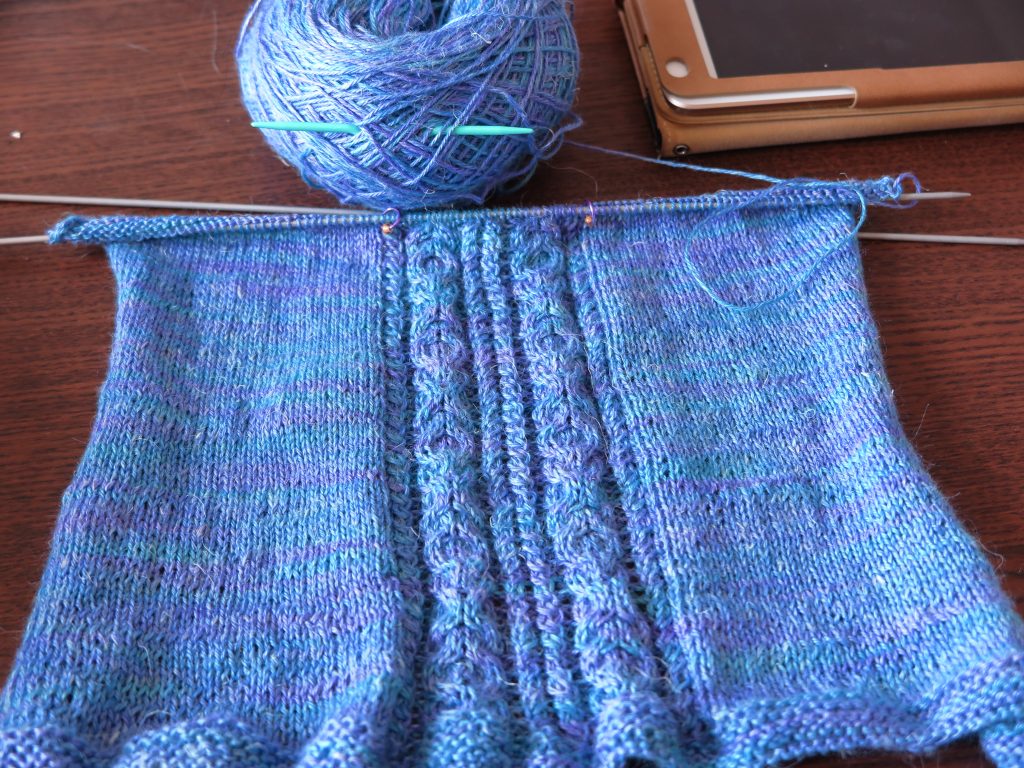I bought a knitting belt at Shetland Wool Week, and this past week I’ve been giving it a go. If you aren’t familiar, it’s an oval shaped leather pad (mine is about 3.5in wide and 8in long) stuffed with horsehair. The front has holes in it for your needles and it has a thin belt that goes around your waist or hips. You use long DPNs and slide the right hand needle into the pad at an angle.
Then, while you knit you don’t need to hold the right needle steady and the weight of the work is held by your left hand and waist. There is no weight on your right hand. In theory this frees your right hand up to manipulate yarn and stitches without the burden of managing the needle. It also makes it far more possible to knit sweaters in the round without circulars, and as things go, good circulars are a fairly recent invention as well as more expensive than straights or DPNs. They are limited to working well with only smaller needle sizes. Thicker needles don’t fit in the holes of the pads.
I’ve had Twisted Lines in my Ravelry queue for a while. I picked it out to use with some yarn I purchased in Lexington VA: B’Luxor. It’s a lovely mix of light blues and purples and it’s made from a rather unique blend of alpaca, linen and silk. I’ve been curious what it would be like to work with. As none of those fibers have memory or much stretch, I picked a pattern that looks like it’ll do fine with some drape and doesn’t rely much on the structure of the yarn to maintain shape.
Front and back are knit separately then sewn together, which seemed a good way to try the knitting belt rather than in the round. It took me three false starts to really get going. My first start had just terribly uneven tension just in the few rows of garter I did. Then I realized that my gauge was different on the knitting belt and I needed to go down a needle size (ahem… yes… I have heard that it’s a good idea to swatch on the same needles to you plan to use. Why do you ask?) and then I miscounted my cast on stitches… Fourth try, got it right.
Then I discovered about 6in in that I’d made a mistake. Can you spot it?

Yeah, I switched directions on my little 1st cable twists. I could:
1. keep working it the wrong direction, messing up the symmetric nature of the patterns
2. change back to the right direction, giving me two spots it switched.
3. go back and fix it.
I decided to go back and fix it. A little cable surgery later et voilà:

Now I’m well on my way to having the back of a tank top! Also the picture below is a much more accurate representation of the yarn color.

Yarn observations:
The yarn is really sturdy. Ripping out my work three times didn’t leave the yarn frizzy or worn looking. Despite being 50% alpaca, it’s not grabby or prone to fuzzing. It is a little splitty between plies though. I can already feel in the fabric that it’s going to have a lot of drape and movement. I’m optimistic that the harder wearing linen and alpaca will limit the signs of wear (see earlier note regarding ripping back work) that silk can show so quickly. The silk does lend it a lovely shine and the colors have that changing and complex nature that reminds me of an early evening sky.
Knitting belt observations:
Wow, but did it feel weird at first! I’m very used to moving both my left and right needles to get the angle I want for stitches. I had to play around a bit to find which angle works best for me when inserting the needle into the pad. I also realized I typically hold my hands very close to my body, but the long needles required that I move them out away from me more. This felt odd at first, but wasn’t as tiring as I feared because more of the weight of the work is held by the belt. I think when knitting on circulars, I need my elbows and forearms tucked up against me so that I transfer the weight to my torso through my forearms instead of letting it all rest on my wrists.
It also took me a bit to stop trying to hold the right needle. I’m a “flicker” by which I mean I don’t let go of the right needle when I go to wrap the yarn around the needle tip: I just “flick” my index finger forward to do this. So I found it really really hard to let go of the right needle. Somebody who is more a “thrower” and used to not holding the needle while wrapping their yarn might find this less odd.
Purl stitches also took a bit for me to get the hang of, again, because only the left needle tip moves. On the plus side, I don’t have to work as hard to keep from rowing out now that I’ve got it down. I have challenges if I’m not paying close attention with this when I knit normally (ie: without the knitting belt) due to how I’m wrapping my yarn (it’s not a tension issue like many beginners run into – it’s more fundamental to my technique). I need to see if I can take what I’ve observed and apply it to the rest of my knitting, or if it’s unique to the belt.
While I can see the potential for speedier knitting for normal stitches and potentially lace, cables are definitely another matter. If you’re used to foregoing a cable needle, these are just harder because you can’t adjust the angle of the right needle. I am using a cable needle for the Xs and Os when normally a simple 2st cross is one I’d just do with the needles. But getting the angle I want between needles requires such crazy movements and manipulations of the left needle that it’s not worth it. The slippery yarn also means I can’t just slide stitches off and hold them in my fingers.
I feel like I need to finish this tank top and maybe a few other projects in different styles/patterns before I can really say how well it works for me.
